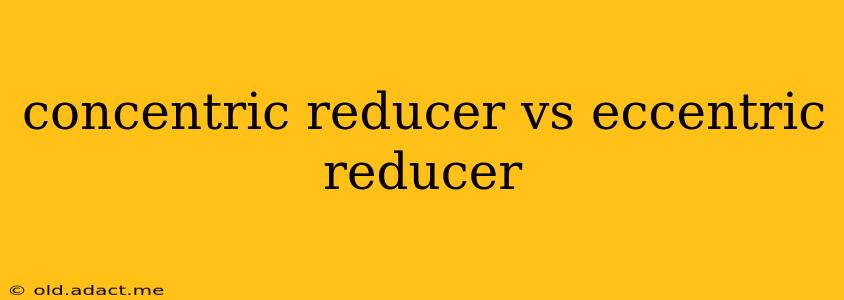Pipe reducers are essential components in plumbing and piping systems, used to smoothly transition between pipes of different diameters. Understanding the difference between concentric and eccentric reducers is crucial for selecting the correct fitting for your specific application. This article will delve into the key distinctions, advantages, and disadvantages of each type, helping you make an informed decision.
What is a Concentric Reducer?
A concentric reducer maintains the centerline of the smaller diameter pipe perfectly aligned with the centerline of the larger diameter pipe. Imagine two circles, one inside the other, with their centers precisely overlapping. That's the visual representation of a concentric reducer. The transition from the larger to the smaller diameter is symmetrical.
Advantages of Concentric Reducers:
- Simplicity: Their symmetrical design makes them easy to install and understand.
- Suitable for many applications: They are generally suitable for most applications where a smooth transition between pipe sizes is required.
- Readily available: They are commonly stocked by most plumbing and piping suppliers.
Disadvantages of Concentric Reducers:
- Sediment buildup: In horizontal applications, sediment can accumulate at the bottom of the smaller diameter pipe due to the gradual reduction in size. This can restrict flow and potentially lead to clogging.
- Not ideal for liquids with solids: The gradual reduction in size can trap solids and impede flow.
What is an Eccentric Reducer?
An eccentric reducer, unlike its concentric counterpart, offsets the centerline of the smaller diameter pipe from the centerline of the larger diameter pipe. This offset creates an asymmetrical transition. Think of two circles, one inside the other, but with their centers slightly shifted. The smaller pipe is positioned either at the top or bottom of the larger pipe.
Advantages of Eccentric Reducers:
- Reduced Sediment Buildup: The offset design allows for a nearly full bore in the smaller diameter pipe, minimizing the chances of sediment accumulation and improving flow efficiency, especially in horizontal pipelines carrying liquids with solids.
- Improved flow for liquids with solids: By maintaining a consistent flow path, they better handle slurries or liquids containing solids, reducing the risk of blockage.
- Better for drainage: In drainage systems, an eccentric reducer positioned with the smaller diameter at the bottom ensures optimal flow, preventing sediment from settling and obstructing the pipe.
Disadvantages of Eccentric Reducers:
- More complex installation: Due to their asymmetrical design, they might require more precise alignment during installation.
- Less common than concentric reducers: They might not be as readily available as concentric reducers in some areas.
- Cost: Eccentric reducers might be slightly more expensive than concentric reducers.
Concentric Reducer vs. Eccentric Reducer: Which One Should You Choose?
The choice between a concentric and eccentric reducer depends heavily on the specific application and the nature of the fluid being conveyed.
-
Choose a concentric reducer if: You are dealing with clean liquids, the application is not critical regarding sediment buildup, and simplicity of installation is paramount.
-
Choose an eccentric reducer if: You need to minimize sediment buildup, the fluid contains solids or sediments, or the application requires optimized flow, especially in horizontal lines. Eccentric reducers are particularly beneficial in drainage systems and pipelines carrying liquids with solids.
How to Choose the Right Size Reducer?
Selecting the appropriate size is just as critical as choosing the right type. Ensure the reducer's dimensions are compatible with the pipes it connects, ensuring a tight and leak-free seal. Consult relevant piping standards and manufacturer specifications for accurate sizing.
What are the different materials used for reducers?
Reducers are manufactured from various materials, including cast iron, ductile iron, steel, PVC, CPVC, and other plastics depending on the application's pressure, temperature, and chemical compatibility requirements.
What are the common applications of reducers?
Reducers find applications in a wide range of industries, including water treatment, oil and gas, chemical processing, and building services, wherever a smooth transition between pipes of varying sizes is required.
By carefully considering the advantages and disadvantages of each type, and understanding the specific requirements of your application, you can ensure you choose the correct reducer for optimal performance and efficiency. Remember to always consult relevant codes and standards to ensure compliance with safety regulations.
